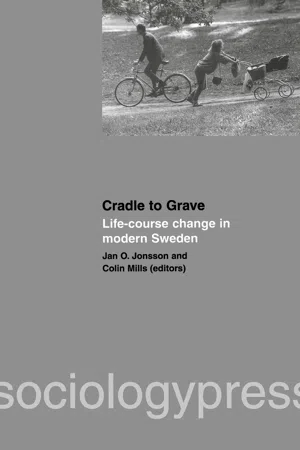Introduction
What is social change? One way of looking at it is to say that successive cohorts of people encounter different living conditions and experience events that may have repercussions for them during their life-course: things that occurred during their childhood may also affect their youth and adult situation. To take a dramatic but obvious example: a war – with its many casualties, destruction of infrastructure and impact on social institutions – can affect several cohorts’ life cycle. Young people’s education is interrupted, families are dissolved, marriage markets become biased and labour-market opportunities are suddenly changed (sometimes for the ‘better’).1
While social change in connection with events such as wars is immediate and obvious enough, by affecting individuals’ life-course it is stretched out over time and takes routes that are difficult to anticipate. The same is true of technical change, economic depression, migration and the introduction of political reforms. Thus, addressing the causal antecedents of life-course changes is as complicated as trying to provide other macrolevel explanations for aggregate microlevel behaviour (cf. Mayer, 1997). However, irrespective of what factors produce social change, such change can be depicted in the life-trajectories of successive cohorts. That is, the ‘lived experience’ of social change is reflected in: the timing and occurrence of important transitions between life stages such as childhood, family formation, occupational career and old age; the interconnectedness of life domains such as family, school and work; and also in the volatility of transitions between states within life stages, such as family dissolution and reconstitution, unemployment and recurrent education. Indeed, in many theories of social change, its nature is described precisely as a change in the timing and sequencing of transitions between life stages, in the relatedness of life-domains, and in the propensities for changing states within life-cycle stages.
It is the aim of this chapter to describe life-course changes in Sweden and thereby give one picture of social change during the postwar period. That is, instead of the traditional exposition of social change in terms of changes in social institutions or in repeated cross-sectional aggregate statistics, this chapter takes the experienced life-courses of individuals from successive birth cohorts as its point of departure. This will not be a comprehensive picture of social change, but a complementary one; and arguably an important aspect that is often overlooked. The analyses will address in particular the alleged change in modern Western societies from a ‘Fordist’ life-course regime to some kind of ‘post-Fordist’ mode of life. The chapter does not address the much more complex question of what underlies changes in life-course regimes – or their stability – but ends with a short discussion of the emerging pattern of life-course changes in the light of other societal changes in Sweden.
Towards a post-Fordist life-course regime?
There are several interrelated ideas concerning how the traditional industrial society has been and is transformed. Theories of the ‘postindustrial’ society have existed since the 1960s, whereas ‘postmodernism’ and ‘globalisation’ are recent relatives. Inspired by these strands of thought, there is a body of sociological literature suggesting a change away from the industrial mode of life (e.g. Beck, 1992; Castells, 2000; Giddens, 1994; Gray, 1998; Myles, 1993). Such social change means that the typical life-course regime for the industrial society is being replaced by a new one, in particular during the latter half of the twentieth century. I will follow Mayer (1993, 1997) in calling this a change from a ‘Fordist’ to a ‘post-Fordist’ life-course regime, although not all of the authors mentioned use that expression, and there is no coherent theory behind such claims.2
What is central in this change is a purported breakdown of borders between life stages and life-domains, resulting in a greater discontinuity or disorderliness of the typical life cycle. It is also argued that people move more freely within life stages, thus increasing individual volatility. One reason for such mobility is the increasing insecurity of employment, including for the middle class. In total, life becomes much less predictable, partly depending on external causes – such as changes in the economy – and partly because individuals’ own will and choices become more accentuated when traditional bonds to one’s origin are loosened.
In the stylised description of the Fordist life cycle, the sequencing of life stages is the traditional: schooling, then work, followed by family formation, and finally retirement for men; and for women, minimal schooling, perhaps a short spell of work, then childbearing and housework. Changes of jobs and of marital partners are few – the traditional industrial life cycle is both stable and predictable. Gender roles are traditional, with men as providers and women as housewives, and class boundaries are strict, with little intergenerational mobility between social classes and limited opportunities for career advancement. However, industrialisation brings with it successive increases in standards of living, with younger generations always doing better than their parents did.
The post-Fordist life-course is supposed to entail prolonged schooling while family formation is delayed. Work is more often interrupted by recurrent spells of unemployment, education and leave of absence for other reasons. A more fluid labour market, together with changes in individuals’ preferences and greater risks of job loss, causes more frequent job shifts and occupational and class changes. In addition, people become less bound to their social origin in their pursuit of labour-market attainment. Women take a more active part in the labour market, which creates a less rigid division of labour between spouses, and greater tension between paid and unpaid work. In tandem, family life itself becomes less stable, with decreasing marriage rates and increasing propensities for separation. In the ‘postmodern’ era, volatility and unpredictability are key life-course characteristics both in work and family life. Also the long-term generational improvement in living conditions is in question. Inequality, in turn, becomes ‘classless’.
There is no single representative exposition of these alleged changes in modern societies that is described here as a shift from an industrial, or Fordist, mode of life to a post-For...
